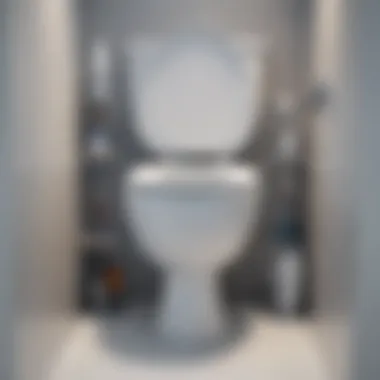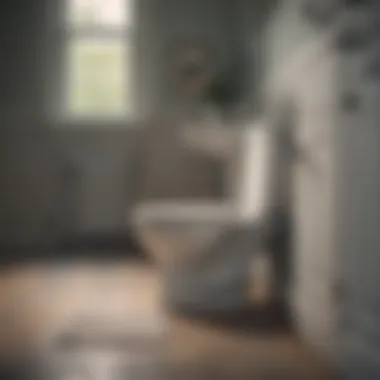Understanding and Resolving Toilet Backups Efficiently


Intro
Toilet backups are an issue that many households experience at some point. They can arise unexpectedly and lead to significant inconvenience and hygiene concerns. Understanding the mechanics behind toilet function and the factors that contribute to backups is necessary for any homeowner. In this article, we will explore the common causes of toilet backups, effective prevention strategies, and corrective actions homeowners can take. Additionally, we will touch upon when professional assistance is required, ensuring you have a well-rounded understanding of the topic.
In exploring this subject, we aim to equip homeowners and design enthusiasts alike with practical knowledge. Knowing how toilets function and what common problems can occur helps maintain the plumbing system. Maintaining an efficient plumbing setup is not just about functionality; it significantly enhances the overall appeal of living spaces. Let's move into a structured examination of the features, maintenance, and best practices to avoid toilet backups.
Intro to Toilet Backups
Toilet backups can create significant discomfort and pose various challenges within a household. They are not merely an inconvenience; they can affect hygiene, the integrity of the plumbing system, and the overall maintenance of a home. Understanding how backups occur and how to address them is vital for any homeowner. In this introductory section, we will explore the various elements central to the topic of toilet backups, emphasizing their significance.
Overview of Plumbing Systems
To comprehend toilet backups, one must first gain insight into the plumbing systems that manage wastewater. A typical residential plumbing system consists of pipes, fixtures, and connections designed to transport waste efficiently. The system operates under gravity, relying on proper slopes and venting to function correctly.
Various materials such as PVC, cast iron, and copper are commonly used in these systems. Each has benefits and drawbacks regarding durability and cost. Understanding these components helps in recognizing where problems may arise, particularly in older homes where systems may not be up to modern standards. Regular inspections and upkeep of these plumbing elements can prevent many issues, including backups.
Significance of Understanding Backups
The relevance of understanding toilet backups extends beyond mere convenience. Knowledge of the underlying causes, symptoms, and solutions empowers homeowners to take proactive measures. This understanding can lead to better maintenance practices, reducing the frequency of such disruptions. Additionally, it allows homeowners to delineate when a DIY solution suffices and when professional help is warranted.
Identifying the signs of a backup, such as unusual water levels or slow drainage, helps in mitigating minor inconveniences before they escalate into serious plumbing failures. Furthermore, a well-informed homeowner can make judicious choices about the plumbing products and materials they use in their homes.
"An informed homeowner is a more empowered homeowner, able to manage home issues effectively without reliance on hastiness or assumptions."
In summary, an introduction to toilet backups encompasses an understanding of plumbing systems and the significance of awareness surrounding them. Through this knowledge, one can maintain a hygienic and functional living environment.
Common Causes of Toilet Backups
Understanding the common causes of toilet backups is essential for effectively managing and preventing this frustrating issue. Every homeowner should be versed in these causes to better maintain their plumbing systems and avoid potential disruptions. Regular awareness of what leads to backups allows individuals to take preemptive actions and minimize inconvenience.
Clogs from Toilet Paper and Waste
One primary cause of toilet backups is the buildup of toilet paper and human waste. While toilet paper is designed to break down in water, excessive usage can lead to clogs. This problem is often worse when too much paper is flushed at once or when multiple uses occur in a short period. It is also compounded by the type of toilet paper used. Thicker, premium brands may not dissolve as easily, causing blockages when combined with waste. Homeowners should consider using less toilet paper and refrain from flushing anything other than bodily waste and toilet paper to avoid this issue.
Foreign Objects in the Toilet
Another common problem involves foreign objects being flushed down the toilet. This includes items such as wipes, feminine hygiene products, and even toys. Many of these items do not break down in water, creating blockages in the system. Once lodged, these objects can make flushing ineffective and may result in severe backups. It’s crucial to educate all household members on the correct items for toilet disposal. Installing a small waste bin nearby can also help prevent these mishaps.
Improper Plumbing Installations
Improper plumbing installations can lead to numerous issues, including backups. When toilets are not installed correctly, the angles of pipes may create areas where waste can easily accumulate. Additionally, inadequate venting can lead to vacuum pressure, causing water to be drawn back into the bowl and creating hidden backups that are not immediately visible. Homeowners should make sure that any plumbing work is done by licensed professionals to avoid future complications stemming from improper installs.
Tree Root Intrusions and Other External Factors
External factors, especially tree root intrusions, can be a lesser-known cause of toilet backups. In older homes, roots from nearby trees can penetrate sewer lines, obstructing the flow of waste. This intrusion can lead to backups that may create health hazards and costly repairs. Homeowners should monitor the health of their sewer lines and consider professional assessments for their plumbing systems. Routine inspections can help prevent significant issues before they start.
"Regular maintenance and awareness of common causes can significantly reduce the risks of toilet backups."
In summary, the common causes of toilet backups stem from various sources that require attention and understanding. Knowing these causes empowers homeowners to maintain their toilets effectively and take preventive actions to avoid messy and inconvenient backups.
Signs of a Backed-Up Toilet


Recognizing the signs of a backed-up toilet is crucial for homeowners. Quick attention can avoid more extensive damage and costly repairs. By identifying these indicators early, you can mitigate the effects on your plumbing and maintain a hygienic living environment. The significance of understanding these signs extends beyond mere discomfort; it can prevent severe plumbing issues that may arise from negligence.
Water Level Fluctuations
One of the first signs of a backup is water level fluctuations in the toilet bowl. If you observe that the water level rises significantly or drops unexpectedly without any flush, it indicates a blockage in the system. This is often due to an obstruction further down in the drain line. Monitoring these fluctuations helps in diagnosing problems before they escalate. Regular checks can save money and stress by allowing timely intervention.
Unpleasant Odors
Another critical sign is the emergence of unpleasant odors. A backed-up toilet can cause sewage gases to seep into your bathroom, presenting both discomfort and health hazards. These smells are not only offensive but may indicate a more severe issue in your plumbing system that requires immediate attention. Ventilation is vital, but ignoring these smells can lead to further degradation of home hygiene. Act quickly and consult a professional if the odors persist, as this could signal bacterial growth or stagnant water.
Slow Drainage and Gurgling Sounds
Slow drainage and gurgling sounds are further indicators of a toilet backup. If the toilet takes longer than usual to empty after a flush, it usually points to a blockage. Gurgling noises often accompany this, as air tries to escape through the buildup of waste. These symptoms signal that the plumbing system is struggling to function correctly. Addressing these signs promptly not only keeps your bathroom operational but also prevents further plumbing complications that require more intensive repairs.
Prompt attention to these signs is key in maintaining a well-functioning plumbing system.
By being observant and addressing these signs of a backed-up toilet, homeowners can ensure proper hygiene and prevent potential damage. Keeping your plumbing system well-maintained protects your investment and enhances your overall living experience.
Preventative Measures for Toilet Backups
Toilets are an essential part of daily life and maintaining their functionality is crucial. Preventative measures for toilet backups not only enhance the operation of plumbing systems but also aid in avoiding costly repairs and health hazards associated with plumbing issues. Homeowners must pay attention to proper usage, regular maintenance, and the selection of flushable products. Each of these measures plays a pivotal role in sustaining a healthy toilet environment, fostering greater longevity and efficiency of the plumbing system.
Understanding Proper Usage
Proper usage of a toilet is often taken for granted, yet it's a fundamental preventive measure against backups. The very function of a toilet relies on efficient flushing, which can be compromised by improper usage. Homeowners should make a habit of educating family members regarding what can and cannot be flushed.
- Toilet paper is designed to disintegrate in water, making it acceptable to flush in limited quantities. However, overloading the toilet with excessive amounts can lead to clogs.
- Waste should ideally be the only organic material flushed. Items like feminine products, wipes, and q-tips should go in the trash instead.
Taking these steps not only reduces the risk of backups but also supports your plumbing system’s integrity over time.
Regular Maintenance and Inspection
Regular maintenance and inspection are crucial to prevent future issues. Homeowners should set a schedule for checking their toilets at least once a year. During this inspection, look for signs of wear or damage, such as:
- Water leaks around the base or tank i- Checking the flapper for breakage, as a malfunctioning flapper can cause continuous running and water waste.
Some other considerations include:
- Cleaning the toilet regularly with appropriate cleaners to prevent buildup.
- Inspecting the plumbing for any unusual noises or drainage problems.
Promptly addressing small problems can prevent larger, more costly issues in the long run.
Utilizing the Right Flushable Products
With the myriad of products available today, choosing the right ones can be challenging. Not all items labeled as "flushable" are genuinely safe or advisable for flushing down the toilet.
- Toilet paper remains the safest choice for flushing. It is specifically designed for quick disintegration once it comes in contact with water.
- Some wipes are marketed as flushable. However, many of them do not break down as effectively as toilet paper, and they can lead to clogs. It is better to place these in the trash.
- Biodegradable options can be a good alternative for those looking for environmentally conscious products.
By being selective with what is flushed, homeowners can significantly mitigate the risk of backups.
Taking proactive measures in toilet care can save time, money, and ensure a functioning home environment.
By understanding proper usage, committing to regular maintenance, and utilizing the right flushable products, homeowners can protect their plumbing from potential backups. This preventive approach not only upholds the hygiene standards of a home but also contributes to a more efficient plumbing system.


Steps to Resolve a Backed-Up Toilet
Toilet backups can disturb the daily flow of household life. Understanding how to effectively resolve such issues saves time, effort, and money. This section outlines systematic steps to address a backed-up toilet while highlighting crucial elements and considerations.
Initial Diagnostic Procedures
Before rushing to solutions, proper diagnostics is essential. Start by observing the symptoms. Check if the water in the bowl is unusually high or low. Listen for any gurgling noises or notice if the toilet drains slowly. These signs can indicate not just a problem with the toilet itself, but possibly with the plumbing system beyond it.
It’s also important to determine if other fixtures are affected. If the bathroom sink or bathtub is also draining slowly, the issue may be larger. Recording these observations provides a clearer picture when seeking solutions.
Using a Plunger Effectively
Using a plunger might seem straightforward, yet proficiency can significantly affect the outcome. First, ensure the plunger is the right type. A flange plunger is best suited for toilets. Make sure the bowl has enough water to cover the rubber part of the plunger. Position the plunger over the drain and create a tight seal.
Begin with gentle pushes. Gently pull back before pushing forward. This creates suction. Repeat this process for about 15 to 20 seconds. After that, check if the water begins to drain. If not, more forceful plunging may be required, but be cautious to avoid splashing or further damage.
Effective plunging can clear many minor clogs without any chemicals or tools.
Employing a Plumbing Snake
When plunging fails, using a plumbing snake may be necessary. Start by inserting the snake into the toilet bowl until it meets resistance. This resistance often signals the location of the obstruction. Turn the handle of the snake clockwise to break apart or pull out the blockage. If the snake catches, gently pull it back, removing any debris it has gathered. This method is more effective for entrenched clogs and is a valuable tool in any homeowner's arsenal.
Chemical Solutions and Remedies
Chemical solutions can be beneficial but require caution. If opting for a chemical cleaner, choose products specifically designed for toilets. Follow the instructions carefully, as improper use can damage plumbing or create hazardous situations. Pour the solution into the toilet bowl and let it sit as directed. After the wait, flush the toilet multiple times to ensure the solution moves through the system.
Additionally, consider natural remedies such as baking soda and vinegar. Pouring these substances into the toilet can help break down organic matter. Wait for a few hours before flushing to achieve better results. However, be mindful that while chemical solutions are quick, they are not always the best long-term answer.
Integrating these various strategies allows homeowners to tackle toilet backups effectively. Through initial diagnostics, proper techniques with tools like plungers and snakes, along with careful use of chemicals, the likelihood of resolving a blockage increases. A comprehensive understanding of these methods ensures a more manageable approach to maintaining home hygiene.
When to Call a Professional
Addressing a toilet backup can sometimes feel like a manageable task, but there are moments when it becomes clear that professional assistance is required. Knowing when to call a professional is crucial to avoiding more severe complications down the line. Engaging plumbers who possess expertise can save time, cost, and frustration. Moreover, pro intervention can ensure that the root of the problem is thoroughly addressed, instead of just applying a temporary fix.
Identifying Complex Issues
In many cases, homeowners can remedy basic clogs with relative ease. However, certain signals indicate that a more complex issue is at play. For example, persistent backups despite multiple attempts at resolution may suggest problems with the sewer line or serious plumbing issues behind the walls. A few red flags to consider include:
- Recurring backups after multiple cleaning attempts.
- Backups occurring simultaneously in multiple toilets or drains.
- Persistent drain odors that worsen over time.
- Slow drainage from multiple fixtures, indicating a potential mainline blockage.
If any of these scenarios arise, consulting a professional plumber is advisable. They can conduct a thorough examination using tools and cameras designed for plumbing diagnostics, providing insights that may not be visible otherwise.
Understanding the Risks of DIY Solutions
Though DIY solutions may seem attractive, they come with inherent risks that should not be overlooked. Using a plunger or auger may seem straightforward, but improper use can inadvertently cause more damage. Amply applying chemical drain cleaners can lead to pipe corrosion, potentially worsening the issue and incurring additional expenses. To illustrate the risks:
- Pipe Damage: Incorrectly applied pressure when using mechanical tools can crack pipes, leading to leaks.
- Health Hazards: Chemical cleaners can pose significant health risks, including respiratory issues and skin irritation.
- Time and Costs: What may begin as a simple repair can escalate into significant costs if professional help is needed later due to DIY complications.
Ultimately, understanding when to call a professional and recognizing the risks associated with DIY methods is critical. By keeping these considerations in mind, homeowners can protect their plumbing systems and mitigate long-term damages.
Costs Associated with Toilet Backups


Understanding the costs associated with toilet backups is essential for homeowners. Many overlook the financial implications until a backup occurs. It is not just about the repairs. There are hidden fees that can affect overall home maintenance budgets. Knowing the potential expenses allows homeowners to allocate funds effectively, reducing stress in emergencies.
Estimating DIY Expenses
Many people attempt to resolve toilet backups on their own. This can be cost-effective but requires a clear understanding of potential expenses. Here are some common cost considerations when tackling DIY solutions:
- Plungers and Augers: Prices vary from $10 to $50. Investing in a good-quality auger can save money in the long run.
- Plumbing Chemicals: Chemical drain cleaners can cost between $5 and $30. While they can be effective, they also carry the risk of damaging pipes if misused.
- Safety Gear: Gloves and goggles are important for protection. Budget around $20 for these necessities.
Calculating the total may help in understanding whether DIY solutions are truly cost-effective. It is also crucial to factor in the risk of further damage, which could increase overall expenses.
Understanding Professional Fees
In some cases, hiring a professional is the only viable solution. Knowing what to expect in terms of fees can prevent surprises. Professional plumbing services may charge based on:
- Service Calls: Standard fees can range from $50 to $150, depending on the region.
- Hourly Rates: Plumbers typically charge between $70 and $150 per hour. Complex issues often lead to longer job times, increasing costs.
- Additional Repairs: If the plumber identifies additional problems (like pipe damage), further costs can accrue.
It is wise to request an estimate before work begins. This ensures there are no hidden charges later in the process.
Overall, evaluating both DIY and professional costs can help a homeowner make informed decisions. Keeping a budget around plumbing problems can reduce anxiety and ensure proper attention to home maintenance.
The Impact on Home Hygiene
Toilet backups not only disrupt daily life but significantly affect home hygiene. The cleanliness of a residence is crucial for the well-being and comfort of its occupants. When a toilet backs up, it can lead to unsanitary conditions, creating health hazards. Thus, understanding this impact is essential for homeowners and those passionate about maintaining hygienic living environments.
Health Risks Related to Backups
A backed-up toilet can lead to various health risks. Contaminated water can harbor bacteria, viruses, and other pathogens. Direct exposure may occur when individuals come into contact with such water. This exposure can result in gastrointestinal issues and other infections.
The restroom often serves as the first line of defense against illnesses. Therefore, maintaining its functionality is vital. Even small backups can lead to mold growth and affect indoor air quality, posing respiratory risks. It is necessary to be vigilant and address any signs of backups promptly.
- Bacterial Growth: Stagnant water can quickly become a breeding ground for harmful bacteria.
- Respiratory Issues: Mold and mildew can develop in damp environments, leading to allergies or asthma.
- Gastrointestinal Illness: Exposure to contaminated water can lead to serious health complications.
"Proper sanitation in bathrooms is critical for the overall health of a household."
Long-Term Consequences of Neglecting Backups
Neglecting toilet backups can lead to severe long-term consequences. These issues often start small but can escalate into significant plumbing problems. For example, frequent backups may indicate deeper plumbing issues, such as blockages in the sewer line. If these issues go unaddressed, they can result in costly repairs and extensive damage to the home.
Furthermore, the impact of a backup can extend beyond immediate inconvenience. Prolonged exposure to unsanitary conditions can irreversibly damage fixtures and encourage pest infestations. Homeowners may face increased expenses, not just from repairs but potential medical costs related to health complications from neglected sanitation.
- Structural Damage: Water leaks can weaken the foundation and walls.
- Increased Repair Costs: Proactive maintenance is always more affordable than extensive repairs.
- Reduced Property Value: Persistent plumbing issues can deter potential buyers.
Culmination
By thoroughly going over the causes, signs, and solutions, the overall knowledge contributes immensely to a homeowner’s toolkit. This approach fosters a proactive mindset, preparing individuals to handle such circumstances when they arise. Beyond mere repair, it enhances the overall appreciation of plumbing as a crucial aspect of home care.
Recap of Key Points
- Understanding Causes: The discussion highlighted the common causes of toilet backups, including clogs from waste, foreign objects, and poor plumbing practices.
- Diagnostic Signs: Recognizing early warning signs such as water level changes, unpleasant odors, and strange sounds can lead to quicker resolutions.
- Preventative Strategies: Recommended regular maintenance and appropriate product usage to reduce the chances of backups.
- Taking the Right Actions: Suggested methodologies for resolving minor issues before they require professional intervention.
- Cost Implications: Clarified both DIY and professional service costs associated with toilet backups.
- Health Considerations: Emphasized the potential health risks and hygiene issues if backups are neglected.
Emphasis on Maintenance and Awareness
Maintaining a toilet is as crucial as any other part of a home’s infrastructure. Routine checks and awareness of one’s plumbing system can lead to early diagnosis of potential problems. Homeowners should familiarize themselves with the supported toilet maintenance practices, including:
- Regular Inspection: Examine the toilet, drains, and plumbing for early signs of wear or clogs.
- Educating Family Members: Inform those living in the home about what can and cannot be flushed to prevent potential mishaps.
- Keep Emergency Supplies Handy: A good plunger, a plumbing snake, and even some basic knowledge of where the main shut-off valve is can mitigate damage.
By fostering a culture of maintenance, homeowners not only protect their property but also ensure a sanitary living experience. An informed approach to everyday plumbing needs creates a foundation for smoother, uninterrupted daily activities. Understanding these elements translates to practical benefits and a greater appreciation for the intricate systems that sustain our living spaces.
Understanding the fundamentals of toilet maintenance ensures fewer disruptions in home life, leading to a cleaner and healthier environment.







